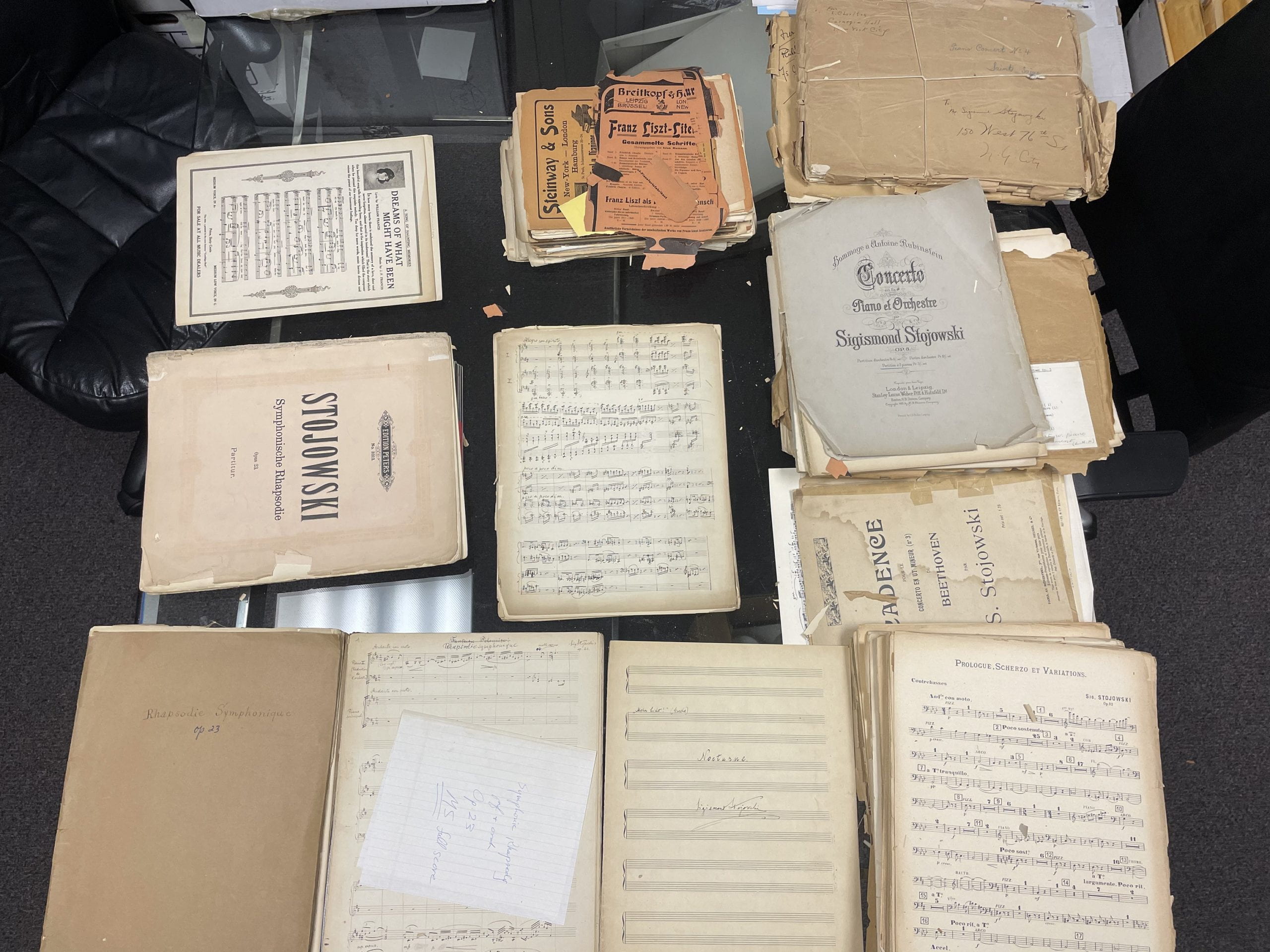The Stojowski Collection Expanded!
In late March, quite unexpectedly, we received an email from Professor Frank Martignetti, chair of the Department of Music and Performing Arts at the University of Bridgeport, Connecticut.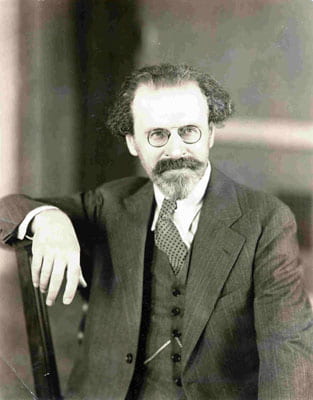 He shared with us some truly stunning news about the materials that once belonged to Zygmunt Stojowski (1870-1946) and were stored at the University of Bridgeport Library in southern Connecticut since 2017.
He shared with us some truly stunning news about the materials that once belonged to Zygmunt Stojowski (1870-1946) and were stored at the University of Bridgeport Library in southern Connecticut since 2017.
Packed into a sizeable box containing published music as well as several of Stojowski’s manuscripts, these items actually came from the estate of a distinguished Dutch violinist, Kees Kooper. Kooper, who died in New York in 2014, was a former parishioner of the Advent Lutheran Church in Manhattan where Prof. Martignetti serves as organist and music director. After arranging for a secure shipment from the East Coast, this treasure finally reached the Polish Music Center about two weeks ago. On May 7, we were able to conduct the inventory of the parcel’s contents as well as sort and place all of the donated materials in acid-free folders.
While a more detailed cataloging and descriptions for each item still await us in the coming months, generally speaking, this collection falls under two broad subject headings: published materials related directly or indirectly to Stojowski, and his original manuscripts. As a virtuoso pianist, Stojowski performed not only his own compositions, but also appeared as a soloist with a variety of orchestras throughout Europe and the U.S. His repertoire included Beethoven’s Op. 37 and Op. 58, Chopin’s F minor, Liszt’s E-flat major as well as Anton Rubinstein’s D minor and Saint-Saëns’s C minor piano concertos.
Although Stojowski’s cadenzas to Beethoven’s Fourth Piano Concerto are considered lost, the facsimile of the manuscript and a published copy of Stojowski’s cadenza to Beethoven’s Third Piano Concerto survived to this day and both the manuscript facsimile and a copy of the cadenza were included this donation. Also in the same category of Stojowski-related published music, we found sets of orchestral parts for Rubinstein’s D minor and Saint-Saëns’s C minor piano concertos. The latter especially was a great favorite of Stojowski, who first performed it with the New York Symphony Society Orchestra under Walter Damrosch in spring of 1906 to very favorable reviews, and continued to perform this concerto into the 1930s. It is very likely that, as a soloist, Stojowski purchased sets of parts for these works and traveled with them throughout his performing career. This fact would also account for a fragile physical state of the music as well as various interpretative marks entered into these scores during many rehearsals and performances.
As for Stojowski’s own music, this donation includes the published orchestral score and set of parts for Stojowski’s Piano Concerto No. 1 in F-sharp minor, Op. 3. Dedicated to the Russian virtuoso, Anton Rubinstein (1829-1894) whom Stojowski knew personally from visits in his home in Kraków, this work was premiered by Stojowski in Paris on 17 February 1891 by the Orchestre Colonne under Benjamin Godard. Stojowski subsequently appeared as soloist in this concerto with the Berlin Philharmonic in 1892 and later that year with Sir Charles Hallé’s Orchestra in Manchester, England, while the U.S. premiere of the work took place with the New York Metropolitan Orchestra on 2 April 1911. Again, various markings throughout these scores will certainly yield additional clues for performers and researchers alike, giving insights to Stojowski’s musical intentions in this brilliant work.
Stojowski’s other major work for piano and orchestra is his Prologue, Scherzo and Variations, Op. 32. This donation includes a set of published orchestral parts, a full orchestral score, a two-piano reduction score, as well as Stojowski’s manuscript drafts for this rather innovative work that—rather ambitiously—sought to reinvent the piano concerto format. Stojowski premiered it with Arthur Nikisch and London Symphony Orchestra at Queen’s Hall on 23 June 1913. Dedicated to Stojowski’s close friend and mentor, Ignacy Jan Paderewski, the dedicatee performed this work on several occasions, including during his appearances with the New York Philharmonic and Walter Damrosch in early March of 1916 and with Boston Symphony Orchestra and Karl Muck a week later.
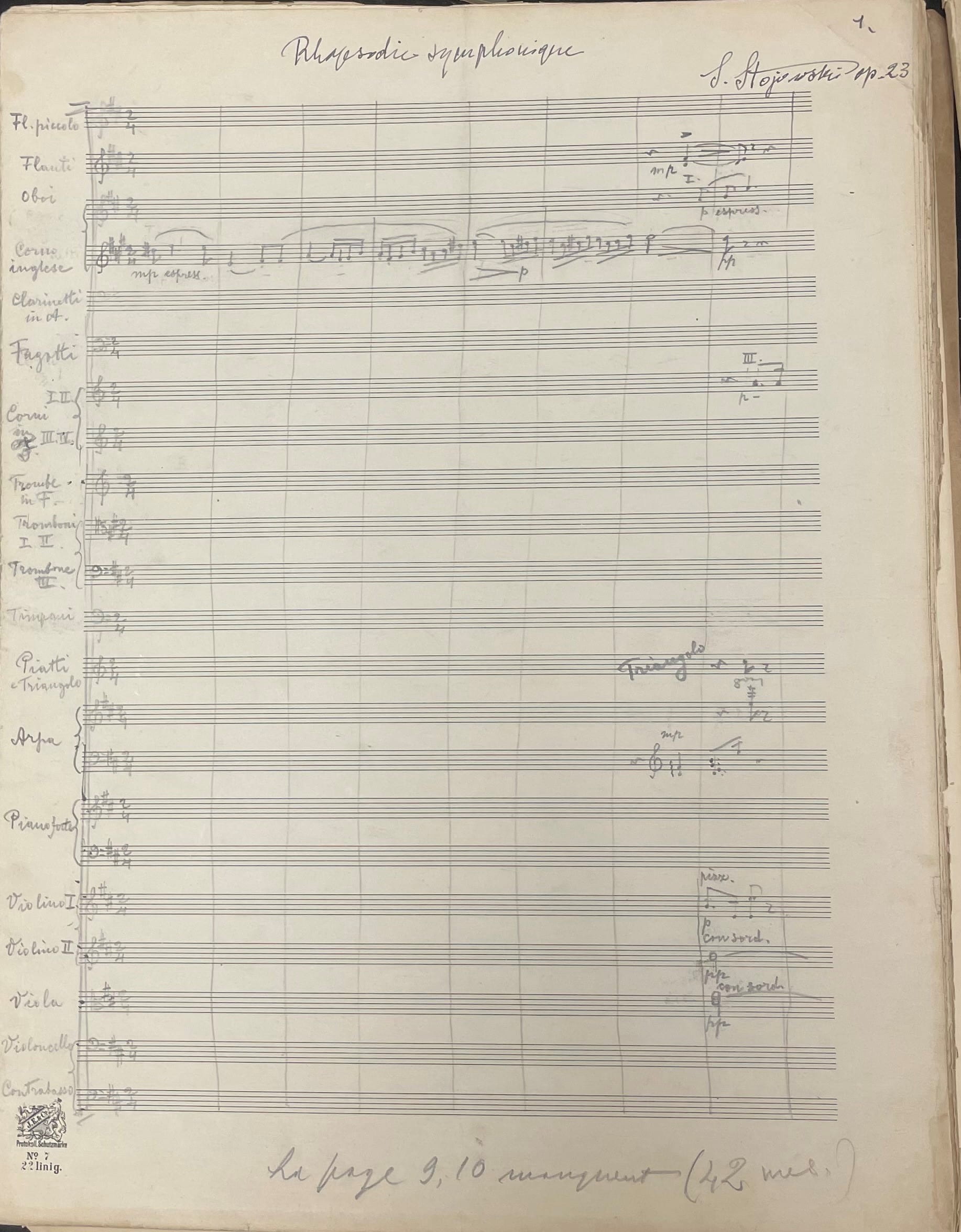
Dating from 1900 and dedicated to another fine pianist, Harold Bauer, Stojowski’s Rhapsodie symphonique, Op. 23 for piano and orchestra is somewhat less known in spite of the fact that the composer performed it on many occasions with leading orchestras in Europe and the U.S., including at the opening season of the Warsaw Philharmonic and Lwów Philharmonic orchestras. The Rhapsodie had won a prize of 250 rubles for the best composition for soloist and orchestra at the Count Zamoyski’s Competition in Warsaw in 1900 and its original title, Fantaisie Polonaise, is actually entered on the manuscript of the two-piano reduction score that was just donated to us. Stojowski later crossed out that title and substituted it on the piano reduction manuscript score with a more general sounding French title of Rhapsodie symphonique. A little later Peters in Germany published this work under the title of Symphonische Rhapsodie, Op. 23, and this version of the orchestral score was included in the donation alongside Stojowski’s manuscript of the Op. 23 full orchestral score.
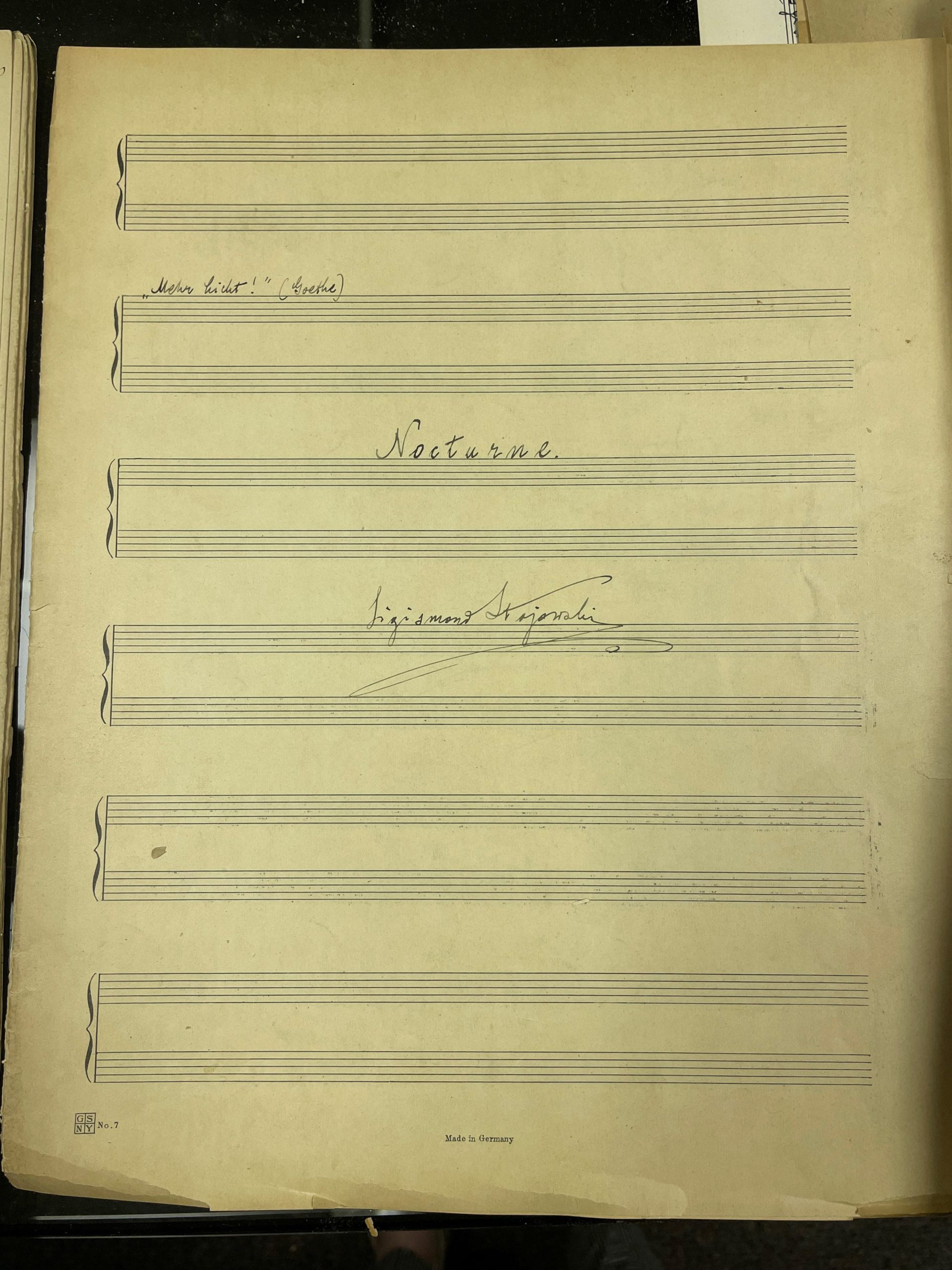
The manuscript of Stojowski’s Nocturne for piano is another absolutely priceless addition to our extensive Stojowski Collection. This short four-page work comes with the celebrated “Mehr Licht” quote from Goethe on the title page and is graced by Stojowski’s florid signature as well. The composer’s signature appears again on the last page of this manuscript with the “19 November 1912” date entered as well. Looking through various listings and catalogues of Stojowski’s compositions (including our PMHS No. 10, Zygmunt Stojowski: Life and Music by Joseph A. Herter), this Nocturne does not appear anywhere and may have remained undiscovered for well over a century!
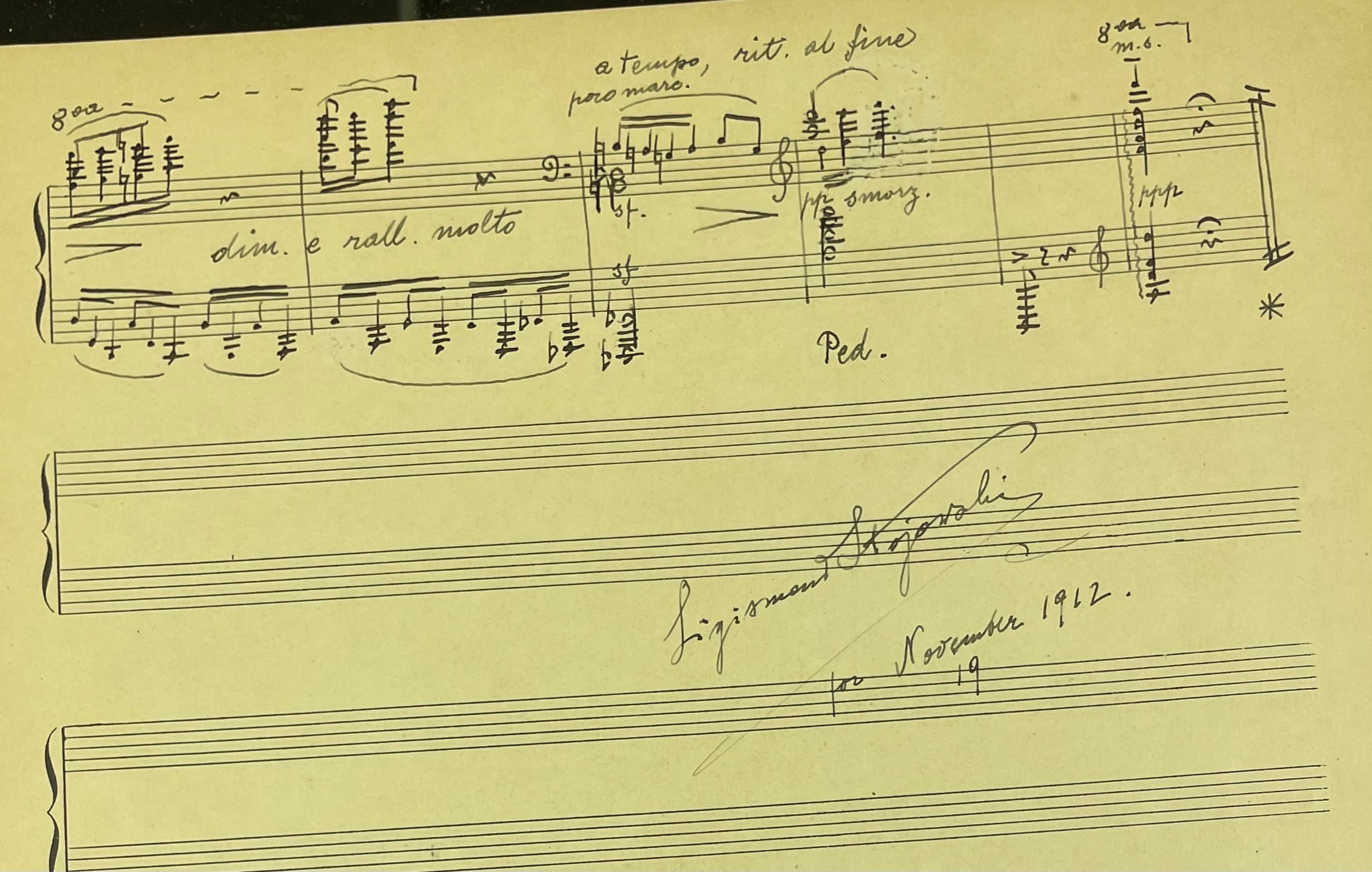
The shipment of the Stojowski materials from Connecticut also included the first edition of his twenty Chansons polonaises, published by Heugel in Paris in 1927. With texts in Polish, French and English, these are actually arrangements of various well-known Polish folk songs and Christmas carols. Still another set of Stojowski’s songs, Euphonies, Op. 33, was also part of this donation. Dating from 1910 and dedicated to Marcella Sembrich-Kochańska, these songs feature poems by Kazimierz Przerwa-Tetmajer and were published by Heugel with French and English translations.
Among the more fascinating published materials that most likely came from Stojowski’s personal library we found the 1863 Breitkopf edition of Chopin’s Nocturnes. Stojowski often featured Chopin’s Nocturnes in his solo concerts and also lectured and wrote about their interpretation. This may have been the edition he consulted for some of his articles and his recitals.
Another interesting—albeit more modern publication—is Presser’s published volume in the Master Piano Lessons series. This particular volume includes three written master classes by Stojowski—on Chopin’s Impromptu Op. 29, Schubert’s Moment Musical, Op. 94 no. 3, and Schumann’s Nachtstück, Op. 23 no. 4 that are amply illustrated with several musical examples, fingering and phrasing suggestions, and other interpretative remarks.
A late 19-century edition of Bach’s St. Matthew’s Passion and a few copies of Die Musik magazine testify to Stojowski’s keen interest in German music scene and his fascination as a composer in one of Bach’s greatest masterpieces. Among other printed materials in this donation we also find a few copies of sheet music by various composers—works for solo piano and voice and piano—as well as a reprint of an article The Human Element in Piano Tone Production by William Braid White.
Undoubtedly, this great collection of Stojowski-related materials will substantially enrich the Zygmunt and Luisa Stojowski Collection that has proudly resided at the PMC since 2005. We are incredibly grateful to professors Frank Martignetti and Jeffrey Johnson, as well as heirs to the Kees Kooper family and the personnel of the University of Bridgeport Library who took good care of these materials for the past few years. If anyone reading this article happens to know of other Stojowski-related materials in need of a good home, please do not hesitate to contact us!
Fleck-Levman Donation
Barbara Fleck, a longtime LA resident, has been a friend of the PMC for well over a decade. During these years, she has donated a number of published scores featuring works by Eastern European composers. Last fall, Ms. Fleck reached out to us about donating a large amount of fascinating and rare photographs, correspondence, music and concert programs and other documents relating to Saul Levman and his family.
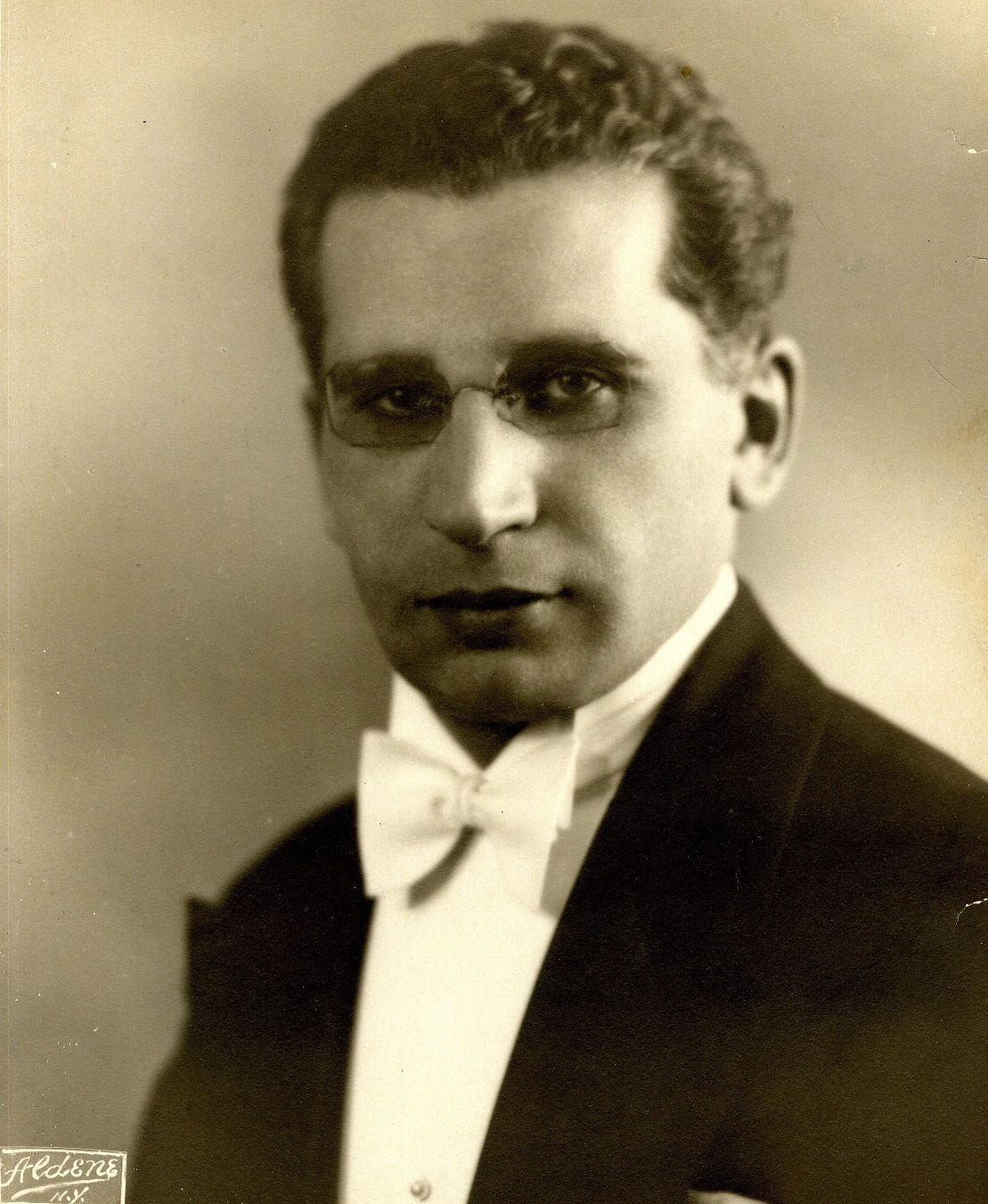
Born in Vitebsk in Russia in 1890, Levman first studied medicine but later transferred to the St. Petersburg Conservatory, where he studied double bass. After graduating in 1913, Levman joined the Koussevitzky Orchestra in Moscow and frequently appeared as soloist as well. In 1918, Levman briefly joined the faculty of Vitebsk Conservatory but was forced to flee to the U.S. after the Bolshevik Revolution. From the early 1920s Levman lived in New York City, where he performed as soloist and as orchestra member of the New York Philharmonic under Walter Damrosch and Arturo Toscanini. He died of a heart attack during an orchestra rehearsal in New York in 1936.
Saul Levman’s only daughter, Henrietta, was a pianist and singer. She studied in Paris with Isidore Philipp and came to join her father in New York in the early 1930s. After his father’s death Henrietta eventually settled in Los Angeles where she worked as an accompanist for many ballet companies. In her later years, she befriended Barbara Fleck, who inherited the substantial Levman archive after Henrietta’s death.
The Levman archive contains many fascinating items associated with the most prominent Eastern European musicians active in the early years of the twentieth century. The rarest items in this collection include concert programs and posters relating to Saul Levman’s performances in Russia in the 1910s (including appearances under the baton of Nicolai Malko), as well as Levman’s correspondence with Koussevitzky after both musicians emigrated to America.
Another special feature of the collection is a significant number of photographs of various musicians and ensembles; some of them include autographed dedications by such musical legends as Erich Kleiber, Thomas Beecham, Bruno Walter, Rudolf Rissland, and Vasily Safonov, among others. There are also programs of the New York Philharmonic concerts and European tour with Toscanini as well as Saul Levman’s original contracts with Stadium Concerts, Inc. and The New York Philharmonic Society, covering the years 1926-1936.
The collection also includes a number of Saul Levman’s personal documents in Russian, French and English (including a U.S. passport) and family correspondence—mainly to him and his daughter, Henrietta in Russian, French and English.
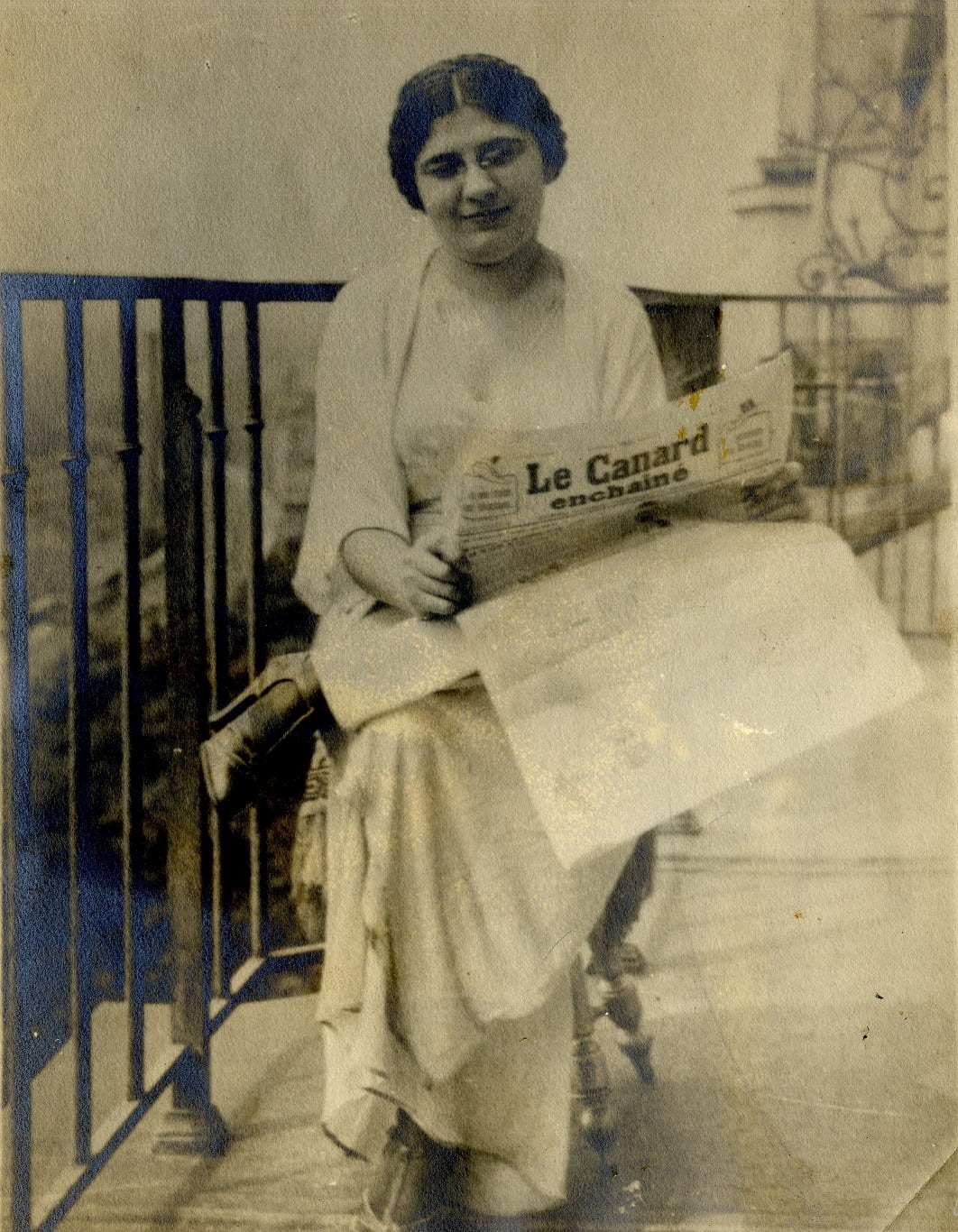
Items that relate directly to Henrietta Levman include a number of her concert programs in France, letters of recommendation and correspondence with Isidore Philipp, as well as his photograph inscribed in French to her. The collection also includes Philipp’s VOX LP recording of music by early Italian keyboard masters, a set of pre-World War I Russian-made postcards with photos of famous musicians (Auer, Chaliapin, Glazunov, Heifetz, Hoffman, Kreisler, Mengelberg, Rachmaninov, etc.), publications such as the 1932 Almanac of Russian Artists in America and a sizeable Levman family photo album that in the coming years will require careful study and preservation.
The National Forum Donation
Our friends at the Narodowe Forum Muzyki (NFM) in Wrocław recently sent us four brand new CD recordings featuring performances by the National Forum ensembles. We were delighted to receive them all since many of these works haven’t been recorded before.
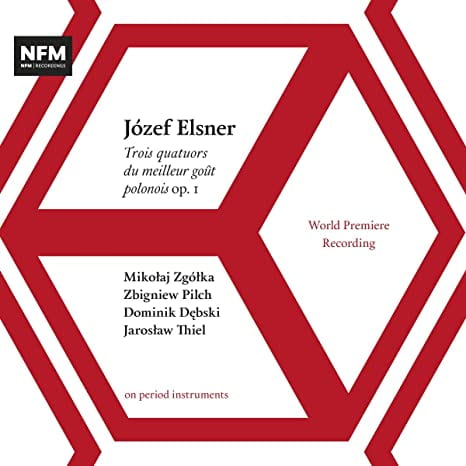 The first CD is a presentation of Trois quatuors du meilleur goût polonois by none other than Józef Elsner (1769-1854), who is chiefly remembered these days as Chopin’s composition teacher. Labeled as Op. 1, these three string quartets represent Elsner’s debut as a composer. They are cast in the keys of F major, A minor and D major, and the first quartet replaces the usual Minuet movement with a more patriotic “Polonoise.” All three quartets are early Romantic salon works that found eager, understanding and gifted performers, including violinists Mikołaj Zgółka and Zbigniew Pilch, violist Dominik Dębski and cellist Jarosław Thiel. Their interpretations on this world premiere recording could also be described as du meilleur goût (or just as tasteful) as Elsner’s charmingly named set. They should enter the repertoire alongside Elsner’s slightly better known orchestral and stage works, where he often used elements of Polish folk music.
The first CD is a presentation of Trois quatuors du meilleur goût polonois by none other than Józef Elsner (1769-1854), who is chiefly remembered these days as Chopin’s composition teacher. Labeled as Op. 1, these three string quartets represent Elsner’s debut as a composer. They are cast in the keys of F major, A minor and D major, and the first quartet replaces the usual Minuet movement with a more patriotic “Polonoise.” All three quartets are early Romantic salon works that found eager, understanding and gifted performers, including violinists Mikołaj Zgółka and Zbigniew Pilch, violist Dominik Dębski and cellist Jarosław Thiel. Their interpretations on this world premiere recording could also be described as du meilleur goût (or just as tasteful) as Elsner’s charmingly named set. They should enter the repertoire alongside Elsner’s slightly better known orchestral and stage works, where he often used elements of Polish folk music.
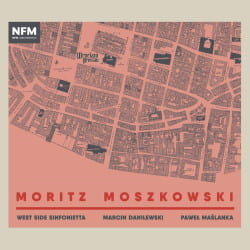
Another excellent NFM recording sent to us in this mailing features Maurycy (Moritz) Moszkowski (1854-1925), a brilliant Polish pianist and a prolific composer of music in the early Romantic style, somewhat reminiscent of Mendelssohn’s musical opus. Conductor Agnieszka Kreiner and the West Side Sinfonietta with violinists Marcin Danilewski and Paweł Maślanka present here the little-known Moszkowski’s Violin Concerto in C major, Op. 30, Prelude and Fugue for String Orchestra, Op. 85 and cap the recording with one of Moszkowski’s best loved works, Five Spanish Dances, Op. 12, originally written for piano four-hands.
 A two CD set of Complete Works by Jacek Różycki (ca. 1635-1703) also included in the NFM parcel will be a very important addition to the PMC sound library. Born to a family of landed gentry, Różycki began his musical journey as a boy soprano in the King Władysław IV ensemble in Warsaw. As such, he was likely present at many concerts featuring the best and most modern music of the day presented at the royal court. Later, after the wars with Russia and Sweden, the royal chapel ensemble in Warsaw was reconstituted in 1657 under Różycki’s leadership, even though the composer was still in his early twenties. He remained music director to several subsequent Polish monarchs, including Jan III Sobieski (1674-1696) and August II (whom he served from 1697 for about six years).
A two CD set of Complete Works by Jacek Różycki (ca. 1635-1703) also included in the NFM parcel will be a very important addition to the PMC sound library. Born to a family of landed gentry, Różycki began his musical journey as a boy soprano in the King Władysław IV ensemble in Warsaw. As such, he was likely present at many concerts featuring the best and most modern music of the day presented at the royal court. Later, after the wars with Russia and Sweden, the royal chapel ensemble in Warsaw was reconstituted in 1657 under Różycki’s leadership, even though the composer was still in his early twenties. He remained music director to several subsequent Polish monarchs, including Jan III Sobieski (1674-1696) and August II (whom he served from 1697 for about six years).
Much of Różycki’s music was unfortunately lost and what remains is only a portion of his substantial opus that formed the repertoire of the ensemble he led for several decades. Only 25 of his compositions are extant and they survived either as early 18th century copies or manuscripts that were transcribed by Adolf Chybiński in the late 1930s and then perished in the Warsaw fires during World War II. The works on this set of CDs include most of Różycki’s liturgical music performed by the Wrocław Baroque Ensemble, ably led by Andrzej Kosendiak.
 The fourth CD from the package sent to us by the National Forum also includes Wrocław Baroque Ensemble led on this occasion by Jarosław Thiel. More lesser-known but fascinating Polish works from the early Romantic era are represented on this disc that opens with Karol Kurpiński’s Elegy in C minor.Born in 1785, Kurpiński is the oldest of the three authors featured on this disc. Primarily remembered as the father of Polish national opera, Kurpiński was the best-known Polish composer before Chopin. The next four tracks on this CD are taken by Ignacy Feliks Dobrzyński (1807-1867) who studied composition with Elsner in Warsaw and was a classmate and friend of Chopin. Dobrzyński’s Symphony No. 2 in C minor (later called “Symphony in the Characteristic Spirit of Polish Music”) won a prize in a composition contest and was also performed under Felix Mendelssohn’s baton in Germany. This extensive, four-movement work certainly merits a wider distribution on the concert stages and this fine recording should prove quite helpful in that regard. The last track on this CD is by Stanisław Moniuszko (1819-1872) whose Bajka [Fairy Tale] Overture is among his best-known orchestral works.
The fourth CD from the package sent to us by the National Forum also includes Wrocław Baroque Ensemble led on this occasion by Jarosław Thiel. More lesser-known but fascinating Polish works from the early Romantic era are represented on this disc that opens with Karol Kurpiński’s Elegy in C minor.Born in 1785, Kurpiński is the oldest of the three authors featured on this disc. Primarily remembered as the father of Polish national opera, Kurpiński was the best-known Polish composer before Chopin. The next four tracks on this CD are taken by Ignacy Feliks Dobrzyński (1807-1867) who studied composition with Elsner in Warsaw and was a classmate and friend of Chopin. Dobrzyński’s Symphony No. 2 in C minor (later called “Symphony in the Characteristic Spirit of Polish Music”) won a prize in a composition contest and was also performed under Felix Mendelssohn’s baton in Germany. This extensive, four-movement work certainly merits a wider distribution on the concert stages and this fine recording should prove quite helpful in that regard. The last track on this CD is by Stanisław Moniuszko (1819-1872) whose Bajka [Fairy Tale] Overture is among his best-known orchestral works.
All in all, in spite of the pandemic and the restrictions to our visits on campus, we are much encouraged by many of our friends all across the world who continue to remember us in so many thoughtful and significant ways. As always, we are happy to respond with formal acknowledgments for their gifts and provide articles about them in this Newsletter in order to share the good news with our readers all around the world.
Thank you! Dziękujemy!
